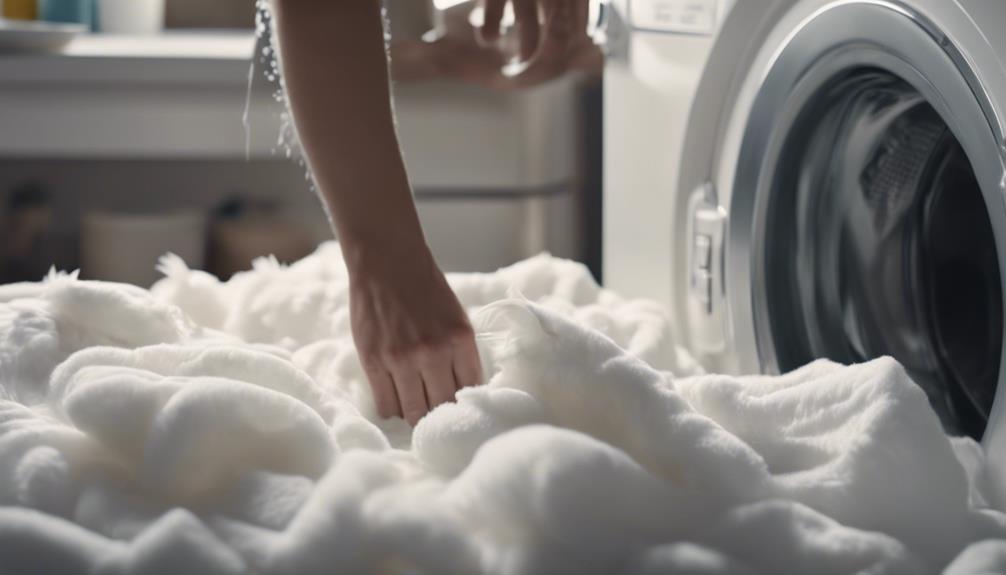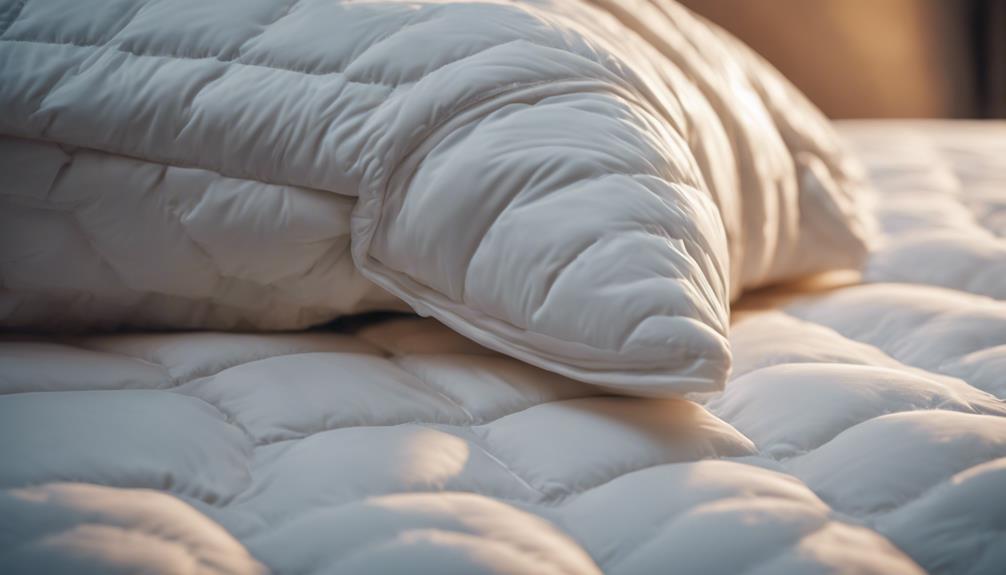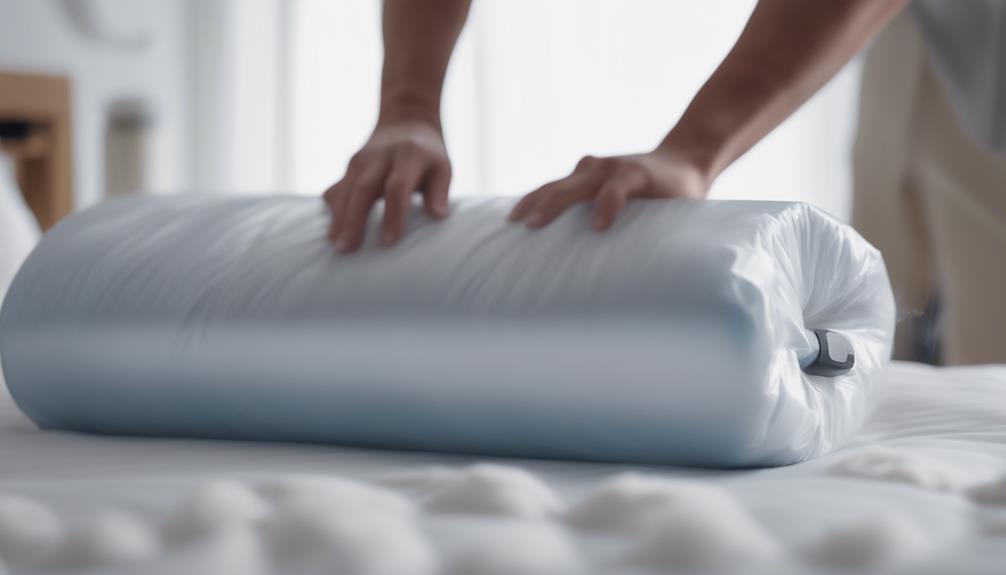When cleaning a down comforter, the use of vinegar is essential. Vinegar serves as a natural disinfectant, helps prevent mold growth, and effectively eliminates odors. It also aids in maintaining freshness and extending the comforter’s lifespan. To clean with vinegar, mix it with water, use a mild detergent, and select a delicate wash cycle. Furthermore, white vinegar is excellent for eliminating odors and acting as a fabric softener. To enhance fluffiness, either air dry or tumble dry on low heat with tennis balls. By following these steps, you can ensure proper care and cleanliness for your down comforter.
Key Takeaways
- Vinegar disinfects and prevents mold in down comforters.
- Use white vinegar to eliminate odors and maintain freshness.
- Incorporate vinegar in washing cycles for effective cleaning.
- Vinegar acts as a natural deodorizer and fabric softener.
- Vinegar helps preserve down fluffiness and inhibits mold growth.
Benefits of Washing Down Comforter With Vinegar

Washing your down comforter with vinegar provides numerous benefits in effectively removing odors and bacteria while maintaining its freshness and loftiness. Vinegar, known for its natural disinfectant properties, is gentle yet powerful when it comes to cleaning down comforters. When you wash your comforter with vinegar, it not only helps eliminate any unwanted smells but also acts as a deterrent to bacteria that may have accumulated over time. The acidity of vinegar aids in breaking down oils and dirt that can get trapped in the down material, ensuring a thorough cleanse.
Moreover, using vinegar as a cleaning agent isn't only cost-effective but also eco-friendly, making it a great choice for those looking to reduce their environmental impact. By incorporating vinegar into your wash cycle, you can rest assured that your down comforter won't only be clean but also retain its fluffy loftiness, providing you with a cozy and sanitary sleeping environment.
Proper Care Instructions for Down Comforters
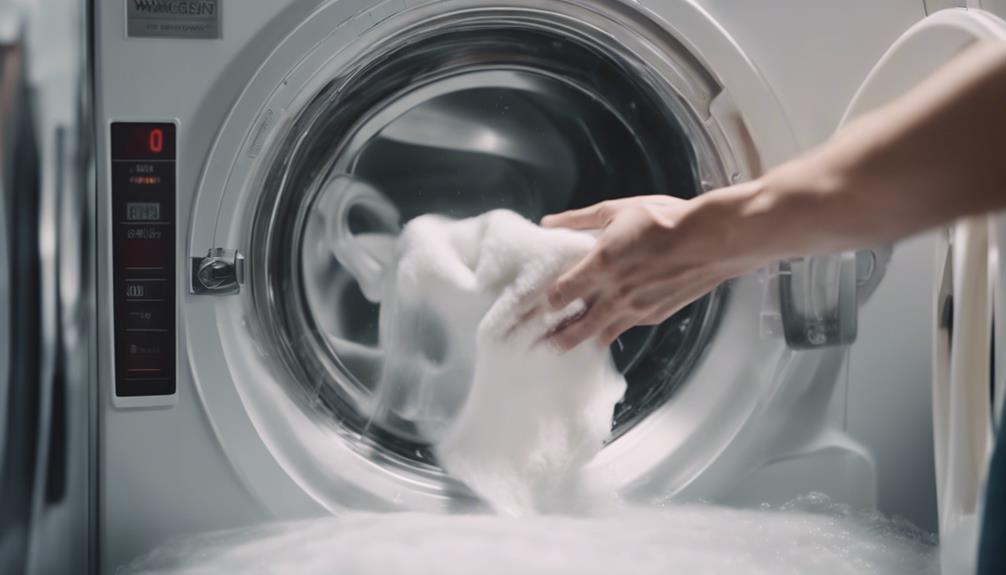
When caring for down comforters, it is crucial to follow specific guidelines to maintain their quality and longevity. Proper care instructions for down comforters include using vinegar in the wash cycle to help remove odors and bacteria, acting as a natural fabric softener that preserves the fluffiness of the down. Vinegar is a mild and effective cleaning agent that safeguards the delicate feathers of the comforter, extending its lifespan. Mixing vinegar with water before adding it to the wash cycle can enhance the cleaning process while being gentle on the down comforter.
| Care Instruction | Description |
|---|---|
| Use Vinegar | Helps remove odors and bacteria from the down comforter, acting as a natural fabric softener. |
| Gentle Detergent | Use a mild detergent suitable for delicate fabrics to safeguard the down comforter remains intact. |
| Fluffiness Maintenance | Vinegar helps maintain the fluffiness of the down, keeping the comforter soft and cozy. |
| Cleaning Technique | Mix vinegar with water before adding it to the wash cycle for effective and gentle cleaning. |
| Wash Cycle | Opt for a gentle wash cycle to protect the delicate feathers of the down comforter during cleaning. |
Steps to Wash a Down Comforter With Vinegar

Let's explore the essential steps involved in washing a down comforter with vinegar to maximize its benefits.
We'll cover how to properly incorporate vinegar into the washing process and guarantee a thorough cleaning of the comforter.
Vinegar Benefits for Comforter
To effectively utilize the benefits of vinegar for washing a down comforter, consider adding it to the rinse cycle for optimal results. Vinegar plays an essential role in cleaning the down comforter by eliminating odors and bacteria that may have accumulated over time.
Its natural fabric softening properties help maintain the fluffiness and softness of the down after washing, ensuring a cozy and comfortable feel. Additionally, vinegar aids in breaking down detergent residue, guaranteeing a thorough and clean wash for the comforter. It can also assist in removing stubborn stains and spots from the fabric during the washing process.
Washing Process Using Vinegar
For effectively washing a down comforter with vinegar, begin by preparing the washing machine and adding the appropriate amount of detergent.
Place the down comforter in the machine and pour half a cup of vinegar into the detergent dispenser. Set the machine to a gentle cycle with cold water to avoid damaging the delicate down filling.
The vinegar will act as a natural cleaning agent, effectively removing odors and bacteria from the comforter. Once the cycle is complete, make sure that the comforter is thoroughly rinsed to remove any residual vinegar.
Importance of Using White Vinegar in Cleaning

Using white vinegar in cleaning is crucial for maintaining the integrity and freshness of a down comforter. White vinegar serves as a powerful cleaning agent that effectively eliminates odors from the comforter, guaranteeing a clean and pleasant sleeping experience.
Additionally, when used during the washing process, white vinegar acts as a fabric softener, helping to preserve the fluffiness of the down feathers. Its gentle cleaning properties break down oils and residues without causing any damage to the delicate down material.
Opting for white vinegar as a natural alternative over harsh chemicals not only guarantees a thorough cleaning but also contributes to eco-friendly practices. By incorporating white vinegar into the cleaning routine, you can effectively remove mildew smells and other unwanted odors, leaving your down comforter smelling fresh and clean.
Make the most of this versatile ingredient to maintain the quality and longevity of your favorite bedding essential.
Tips for Removing Moldy Smell in Comforters

When dealing with a moldy smell in comforters, it's important to utilize effective techniques for odor removal.
Preventing mold growth is vital to make sure the comforter stays fresh for longer periods.
Natural deodorizing methods like using vinegar can be a valuable tool in combating musty odors.
Moldy Smell Removal Techniques
To effectively remove moldy smells from comforters, consider using white vinegar during the wash cycle. White vinegar is known for its effectiveness in eliminating moldy odors from down comforters. Adding vinegar to the wash cycle can help break down the musty smell, leaving your comforter fresh and clean.
Additionally, exposing the comforter to sunlight after washing can further aid in removing moldy smells. It's important to make sure the comforter is fully dried to prevent any lingering odors. If the moldy smell persists, professional dry cleaning services can also be a reliable option for thoroughly removing the unpleasant odor from your comforter.
Regular maintenance and proper drying techniques are key to keeping your comforter smelling fresh and clean.
Preventing Mold Growth
Implementing regular cleaning routines is essential for preventing mold growth in comforters and effectively removing any lingering moldy smells.
To prevent mold from developing on your down comforter, consider using vinegar during the washing cycle. Mixing warm water with vinegar can act as a natural disinfectant, killing mold spores and eliminating musty odors.
Adding white vinegar to your wash cycle not only refreshes the comforter but also helps in preventing mold growth.
After washing with vinegar, exposing the comforter to sunlight can further aid in removing moldy smells and disinfecting the fabric.
Natural Deodorizing Methods
Using white vinegar as a natural deodorizer is an effective method for eliminating moldy smells from a down comforter. Adding white vinegar during the wash cycle can help remove odors effectively. Sunlight exposure aids in reducing moldy smells in a comforter treated with vinegar. Harsh detergents like bleach should be avoided when trying to eliminate odors from a comforter. Line drying and spinning the comforter after washing with vinegar can assist in eradicating moldy smells.
| Effective Methods for Removing Moldy Smells |
|---|
| 1. Use white vinegar during wash cycle |
| 2. Sunlight exposure after treatment |
| 3. Avoid harsh detergents like bleach |
Drying Techniques for Down Comforters

After washing a down comforter with vinegar, gently shake it out before proceeding with the drying process. It's crucial to dry the comforter properly to maintain its fluffiness and guarantee it's completely dry to prevent mold growth.
Here are some effective drying techniques for down comforters:
- Air Dry: Hang the comforter outside on a clothesline or lay it flat on a clean, dry surface. Make sure the area is well-ventilated to aid in the drying process.
- Low Heat Tumble Dry: If using a dryer, select the lowest heat setting to prevent damage to the down filling. Add a few clean tennis balls to the dryer to help fluff up the comforter.
- Fluff Periodically: During the drying process, pause occasionally to fluff the comforter by hand or give it a gentle shake to redistribute the down evenly.
Preventing Mold Growth in Down Comforters

To maintain the freshness of a down comforter and prevent mold growth, incorporating vinegar into the washing process serves as a natural disinfectant and mold deterrent. White vinegar, known for its mold-killing properties, is effective in eliminating mildew odors from down comforters. Adding vinegar to the washing machine during the cleaning cycle can help prevent mold and mildew buildup, keeping the comforter fresh and mold-free. Sunlight exposure post-wash can further inhibit mold growth in down comforters, as sunlight is a natural mold deterrent.
| Benefits of Using Vinegar in Washing Down Comforters | |
|---|---|
| Acts as a natural disinfectant | Helps prevent mold growth |
| Eliminates mildew odors | Inhibits mold and mildew buildup |
| Enhances freshness of comforter | Natural mold deterrent |
Vinegar as a Natural Deodorizing Solution
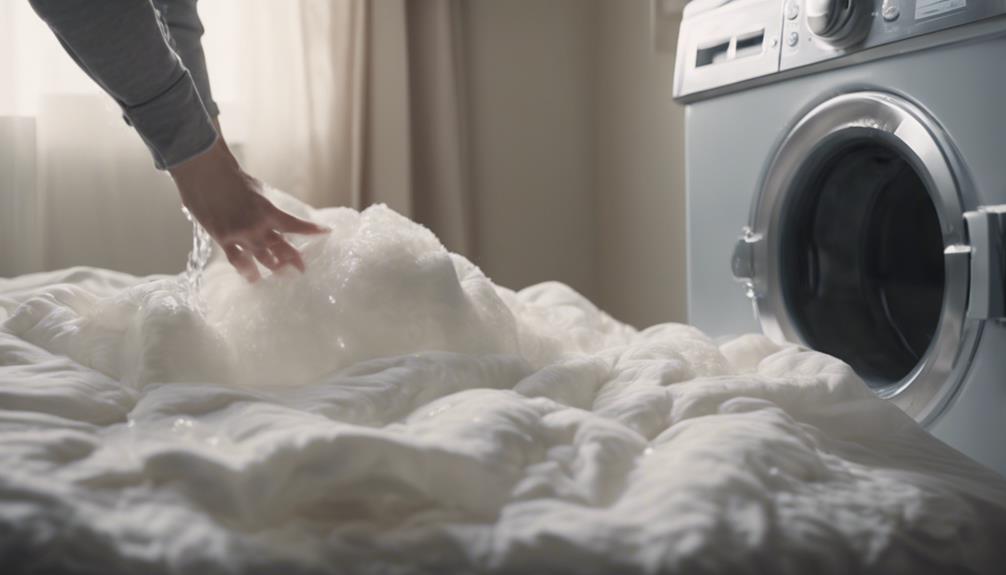
In our experience, incorporating white vinegar into the washing cycle effectively neutralizes odors in down comforters, providing a natural deodorizing solution. White vinegar is a versatile ingredient that helps eliminate musty smells and refresh the comforter without the use of harsh chemicals.
Here are some key points about using vinegar for deodorizing down comforters:
- Vinegar acts as a natural deodorizer, breaking down odor-causing bacteria in the fabric of the comforter.
- Adding vinegar to the wash cycle helps remove lingering odors, leaving the down comforter smelling fresh and clean.
- White vinegar is a safe and eco-friendly alternative to chemical deodorizers, making it a great choice for those looking to avoid harsh substances in their bedding.
Maintaining Down Comforter Quality

Maintaining the quality of a down comforter involves regular care and attention to guarantee longevity and peak performance. Washing your down comforter with vinegar not only helps eliminate odors and bacteria but also aids in preserving its fluffiness. Vinegar, being a natural cleaning agent, is gentle on the delicate down feathers, making it an ideal choice for cleaning.
By adding vinegar to the wash cycle, you can effectively remove mildew and musty smells that may have accumulated over time. This process not only refreshes your comforter but also ensures that it remains clean and free from harmful bacteria. Additionally, using vinegar is a cost-effective and environmentally friendly alternative to harsh chemicals, safeguarding the quality of your down comforter for years to come.
Frequently Asked Questions
How Do You Wash a Down Comforter Without Ruining It?
When washing a down comforter, it's crucial to protect its fluffiness and integrity. Start by checking the care label for specific instructions.
Use a gentle detergent in a large-capacity machine on a delicate cycle. Adding a couple of tennis balls can help maintain the fluff. Guarantee thorough rinsing to remove all soap residue.
Air dry or use a large dryer with low heat and periodically fluff the comforter to maintain its loft.
How to Wash White Comforter With Vinegar?
We can wash a white comforter with vinegar to help remove odors and bacteria while maintaining its fluffiness. Adding vinegar to the wash cycle acts as a natural fabric softener, preserving the comforter's quality.
White vinegar is gentle and effective, aiding in the removal of mildew smells and musty odors. This cost-effective and eco-friendly method is a great way to keep your comforter fresh and clean.
How Do I Get My Down Comforter White Again?
To get a down comforter white again, start by pretreating any stains with a mixture of vinegar and water. Then, wash the comforter in a large capacity machine with a gentle detergent and add a cup of vinegar during the rinse cycle. This will help whiten the fabric and remove any discoloration.
How Do You Keep a Down Comforter Fluffy After Washing?
To maintain a down comforter fluffy after washing, make sure to provide proper care. Use a gentle cycle with mild detergent and add vinegar to the rinse cycle.
Vinegar helps remove residue, acts as a fabric softener, and restores pH balance. It also acts as a deodorizer.
Following these steps will preserve the fluffiness of your down comforter, keeping it fresh and cozy for a long time.
Is Washing an Alternative Down Comforter the Same as Washing a Down Comforter with Vinegar?
Washing an alternative down comforter is different from washing a down comforter with vinegar. While vinegar can help fluff up and deodorize a down comforter, an alternative down comforter may require specific cleaning instructions to maintain its quality and lifespan. Always follow the manufacturer’s recommendations for best results.
Conclusion
To sum up, washing a down comforter with vinegar can be a beneficial and natural way to keep it clean and fresh. By following proper care instructions and using white vinegar, you can effectively remove dirt, stains, and odors from your comforter.
Remember, prevention is key to maintaining the quality of your comforter. As the saying goes, 'An ounce of prevention is worth a pound of cure.' So, take care of your down comforter with vinegar for lasting comfort and coziness.
